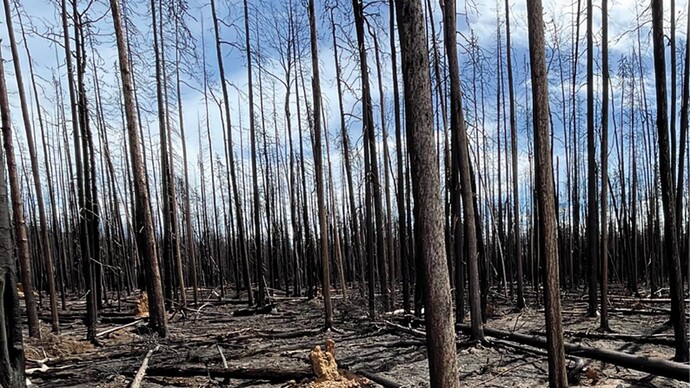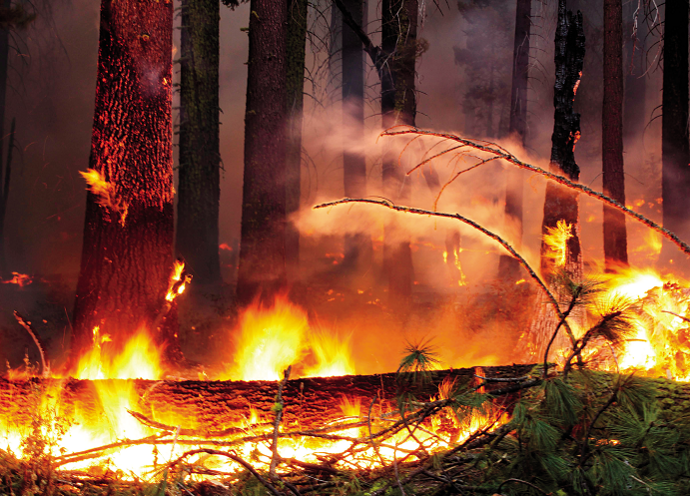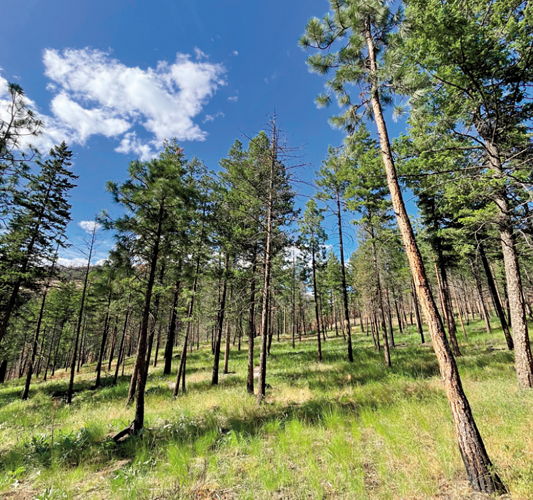Those who work in the woods know all too well that wildfires are undiscerning in what they burn: working forest, parks, old growth forests, wildlife habitat—if there is fuel, it will burn. No matter what your view on how our forests should be managed, it is hard to avoid the reality that wildfire is a threat to our businesses, our livelihoods, as well as to our health and well-being.
Wildfire is not an issue relegated to the backwoods of B.C… We have seen its impacts on Lytton, West Kelowna, and just earlier this year near Fort Nelson. To gain a better sense of community perspectives regarding wildfire resiliency, the BC Council of Forest Industries (COFI) worked with Abacus Data to survey 1,500 British Columbians last spring1. The survey found the public perceives wildfires as a problem that is getting worse.
Polling showed that 75 per cent of the public follows the news about wildfires closely; in other words, it is a top-of-mind subject; 35 per cent reported that wildfires have already had a large impact on their lives with 74 per cent having experienced smoke from wildfires. This data tells us that wildfire is a relevant topic for all British Columbians, even for those in urban centres like Vancouver.
Fortunately, for a province covered in forests, we are not without options. A recent study from the USDA Forest Service reviewed scientific literature from over 40 studies and concluded “proactive ecological forest management can change how fires behave and reduce wildfire severity, under a wide range of conditions and forest types… in reducing surface and ladder fuels and tree density through thinning, coupled with prescribed burning or pile burning could reduce future wildfire severity by more than 60 per cent, relative to untreated areas.”2
Public opinion is aligned with the science on efforts to manage wildfire. In a recent survey, 84 per cent of the public said they think it is a good idea to conduct fuel reduction treatments such as thinning. Below is lodgepole pine, thinned and pruned, in the Burns Lake Community Forest.
The good news is that public opinion is aligned with the science on efforts to manage wildfire. Abacus Data noted that 90 per cent of people surveyed believe it is possible to reduce the risk of extreme fires. Furthermore, 84 per cent of the public thinks it is a good idea to conduct fuel reduction treatments such as thinning. The polling showed almost everyone thinks forest fire severity can be reduced, that proper forest management is a good idea and that there is an acceptable solution available.
There are several approaches to reducing biomass or wood-based fuels in our forests. No single approach will be effective across the province. Treatments should be aligned with the ecology of the sites where treatments are planned. Wildfire ecologists advocate that some of these fuel reduction practices should include using fire as a tool (as was historically deployed by Indigenous peoples). Even post-harvest broadcast burning is under consideration to be reintroduced after falling out of favour in the 1990s due to concerns, ironically, over smoke. Another approach is changing our practice of reforesting solely with conifer tree species, thereby allowing more deciduous trees to grow.
Mechanical work such as commercial thinning to reduce tree densities and opening up the crown canopy offers promising results that not only help to enhance resiliency to wildfire, but promote stand conditions favourable for wildlife and biodiversity. And of course, fibre collected from thinning could potentially be consumed by B.C. mills, which currently struggle to access fibre.
So, it’s a positive that forestry is viewed by the public as part of the solution to the wildfire crisis, and even could become a win-win scenario in terms of fibre supply. Adding support for the cause is the growing anecdotal evidence here in B.C. that these fuel reduction treatments, including thinning, are effective in slowing down the pace of spread of a fire and reducing a fire’s severity. Unfortunately, the amount of area treated so far is miniscule in comparison to the task at hand for the province.
Frustratingly, despite the obvious threat, funding has not yet matched the need. While B.C. has budgeted $60 million over three years to the Forest Enhancement Society of BC (FESBC), it will take billions to create a meaningful impact across the landscape. To quote someone right on the frontline who has seen the value of fuel reduction work, at UBC Forestry’s Wildfire Coexistence in BC: Solutions Symposium in June, West Kelowna Fire Chief Jason Brolund, stated: “we are spending dollars on the wrong end of the problem”, in reference to the billions currently being spent on suppressing wildfires, and the comparatively small amount allocated to proactive measures.
The challenge is monumental given the vast area of forests in B.C. So far, most public conversations have centred around describing the wildfire threat, but there seems to be significantly less conversation to operationalize the effort required. How does the forest sector including industry rise to the occasion?
Last May, I visited a couple of recently thinned areas in the Prince George region and was told the thinning portion of the fuel mitigation work was cash positive. If that remains the case, a major ramp-up on commercial thinning presents significant opportunities for contractors and for the broader fuel reduction campaign. Should this practice begin to catch on, is the forestry services supply chain prepared to support this new area of activity?
Looking specifically at those who do the physical work of reducing fuels, to tackle the challenges ahead, B.C. may once again be on the cusp of another wave of new innovative practices including new equipment. I would liken it to 2015 when new ground-based, steep slope tethering systems from New Zealand were being introduced in the province. At that time, operators were just at the start of the learning curve on what worked best in terms of productivity, costs and safety. Several questions are now being asked on potential thinning and other fuel reduction work:
- Can contractors use their current fleet of equipment, or will they need more specialized equipment?
- What works best and in what conditions – tracked or wheeled machines?
- Do we need smaller cutting and processing heads?
- Does size of machine matter – regular versus new micro-equipment?
- Do we have sufficiently trained professionals to prescribe the work?
- Do we have enough skilled machine operators, particularly if there is a shift to wheeled machines?
Just like with the surge of new steep slope specific equipment that came from New Zealand, there are several equipment options from Europe where thinning has been practiced extensively. To answer these questions, the sector needs to come together, like in the early years of tethering and winch systems, to figure out best practices to embrace that technology and instill confidence to build capacity.
While the provincial budget has yet to match the amount of work needed, the B.C. government is starting to think about the future in terms of equipment. The B.C. government just recently launched WREST—the Wildfire Reduction Equipment Support Trust with $5.25 million to encourage the purchase of specified equipment for the purposes as outlined in this article. WREST will provide reimbursement for the lesser of 10 per cent of the total cost or $100,000—refer to wrestrust.ca for more details. More is needed.
There is no denying that there is a wildfire crisis facing British Columbia. Wildfire ecologists are sounding the alarm. While fuel reduction work has begun, it is nowhere near enough at pace to tackle the problem. Even though the potential need for this work is staggering, it will not all happen overnight—time is required to build up the expertise and acquire, if necessary, new equipment.
There are several approaches to reducing biomass or wood-based fuels in B.C. forests, and no single approach will be effective across the province. Shown is a thinned ponderosa pine stand, near Kelowna.
One final set of insights from the Abacus Data polling suggests there is strong support for the B.C. government in adopting (or funding) fuel reduction treatments with broad, cross-partisan support for action—this means a difference in politics is not preventing us from moving forward. Furthermore, people think industry and government should work together. Collaboration on ramping up the effort, figuring out the funding when necessary and answering the many questions is the way forward.
Given the public survey findings, the B.C. forest sector, including government and industry, is clearly supported in implementing forest management activities to reduce the risks of wildfire. Climate change and increasing severity of wildfires will continue without question. So let’s get busy and make the necessary investments and collaborations to turn that public support for forest management solutions for forest fuel reduction into reality!


